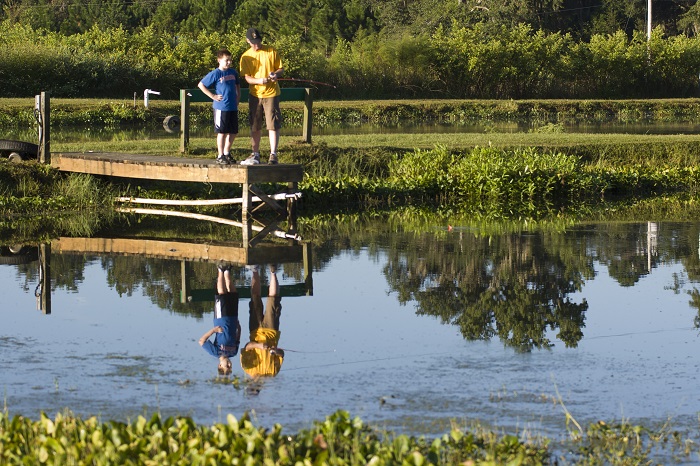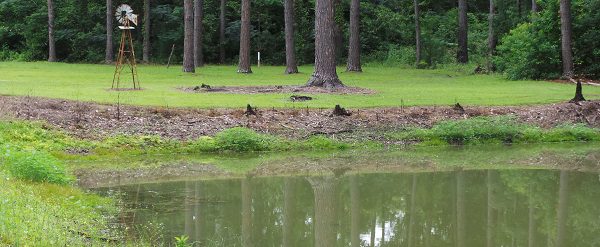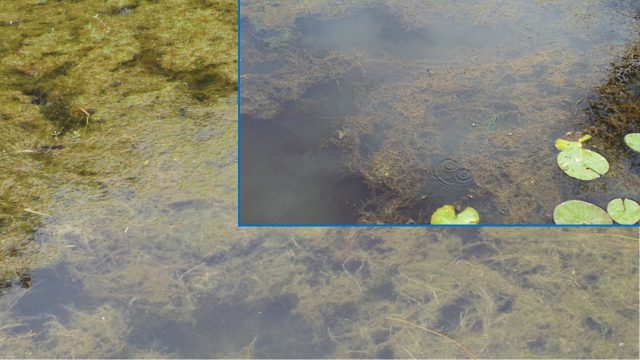
Weeds can transform a pond from a source of enjoyment to a source of frustration. Utilizing a logical, systematic approach to aquatic weed management can greatly increase your likelihood of success. UF/IFAS Photo by Tyler Jones.
Every year as the temperatures get warmer the number of calls related to weed problems in fish ponds increases. That was the case this year also, with one notable difference; the calls started coming in March and April, not June and July as they would during a “typical” year. Aquatic weeds typically die back or have greatly reduced growth rates during the winter months. This past winter was very mild, however, so many aquatic weeds got an early start this spring. So, what does this mean for pond owners? Whatever level of weed pressure you’ve had in recent years will likely be worse this year. With that in mind, the following are a few suggestions to help you keep your aquatic weed issues under control or, if it’s too late for that, find more success in you control efforts.
Limit nutrients entering you pond
If you are still in a position where you are preventing aquatic weed problems, congratulations. Perhaps the single biggest thing you can do to prevent or limit the severity of aquatic weed infestations is to limit the amount of nutrients that enter you pond. In many instances, aquatic plant growth is limited only by nutrient availability, when nutrients like Nitrogen and Phosphorus are introduced to a pond plant and algal growth can increase dramatically.
Nutrients can come from many sources: fertilizers applied close to the water’s edge, livestock manure, grass clippings and yard waste discarded in the pond, and fish feedd are common sources of nutrients that find their way into farm ponds. Nutrients are often washed into ponds via runoff from the surrounding landscape. A barrier of vegetation around the shoreline can help lessen the amount of runoff that enters the pond. Limiting the amount of nutrients available, and their ability to enter your pond will go a long way to minimize the aggravations associated with aquatic weeds.

Keeping shorelines completely void of vegetation might be more convenient for fishing but bare banks do nothing to prevent run off from entering the pond. Allowing the grass to grow immediately adjacent to the water’s edge would be preferable. Photo Credit: Mark Mauldin
Monitor your pond closely and address changes quickly
As a pond owner, you, most likely, see your pond more often than anybody else. This puts you in the best position to notice small changes. Aquatic weeds can be dealt with fairly easily and with relatively little expense, if they are addressed when the weeds are new and the infestation is small. This is in stark contrast to the effort and expense that are often associated with cleaning up a severe infestation. Anything that is different is worth noticing and monitoring. Management practices should quickly be applied to any new weeds that show signs of spreading. This close monitoring is also essential after problem weeds have been managed to help insure re-infestation does not occur.
Identify problem weeds – Don’t guess
I wish this suggestion went without saying, but experience has taught me that it is not unheard of for pond owners to undertake a course of action without knowing precisely what weed(s) they are up against. As previously eluded to, aquatic weed control efforts are not easy and can be quite expensive. Don’t risk wasting time and money on a control plan that is not built on solid facts. Take the time to get all the weeds you are fighting identified. Effective management plans are very specific. There is no, best herbicide for all weeds. To further complicate matters, multiple species of aquatic weeds frequently grow mixed together. All problem species will need to be identified and accounted for in the management plan for satisfactory results to be achieved.

Two images of a common combination of aquatic weeds in Washington County, spikerush and filamentous algae. Correctly identifying both of these species is key to developing an effective management plan. Different herbicides would be needed to control each species and grass carp show very different preferences for each species. Photo Credit: Mark Mauldin
Evaluate all control options
You noticed a new problem weed; you got the weed identified; now you want to do something about it. With aquatic weeds, like most problems in life, you have options. For a given weed scenario there are control measures that will work well, some that won’t work at all, and many that fall somewhere in between. As a pond owner you must balance the effectiveness of a given control option with the associated expense and effort. Control options could include physical removal of the weeds, introduction of herbivorous fish (triploid grass carp), the use of an aquatic herbicide(s), or any combination thereof.
More often than not, my conversations with clients regarding aquatic weed control options, center on the use of aquatic herbicides. There are many products to choose from that vary considerably in their efficacy on specific weed species, price, local availability, and ease of use. Selecting the correct herbicide is crucial. Just because a product is on the shelf at the local retailer does not mean that is the best option for the situation you are facing.
[important]Note: Even if an appropriate herbicide is selected it must be applied correctly in order to be effective. Carefully read and follow all label instructions when using any herbicide. The keys to effective herbicide use are often in the application information provided in the label.[/important]
Don’t be afraid to ask for help
Aquatic weed management is complicated. There are more factors to consider those addressed here. Chances are that if you own a pond, you will have to deal with aquatic weeds this year. Don’t let the situation overwhelm you, approach it with a well thought out plan. There are resources available to assist you; take advantage of them. There are links to a variety of online resources throughout this article. Additionally, your county’s UF/IFAS Extension agent(s) are available to provide you additional information on any of the topic addressed and help you develop a plan for addressing your aquatic weed issues.
For more information related to this topic, use the links to the following publications:
Weed Control in Florida Ponds
Southern Region Aquatic Weed Management: Herbicides
Grass Carp: A Fish for Biological Management of Aquatic Weeds in Florida
- NW FL Ag Service Directory – Find the Service Providers You Need or Advertise the Services You Offer - February 21, 2025
- 2025 Panhandle Corn & Soybean Update – Recap & Presentations - February 14, 2025
- Plan Now for the Big Melon Contest and Junior Jubilee Contest Kick-Off Meeting – February 18 - February 7, 2025
